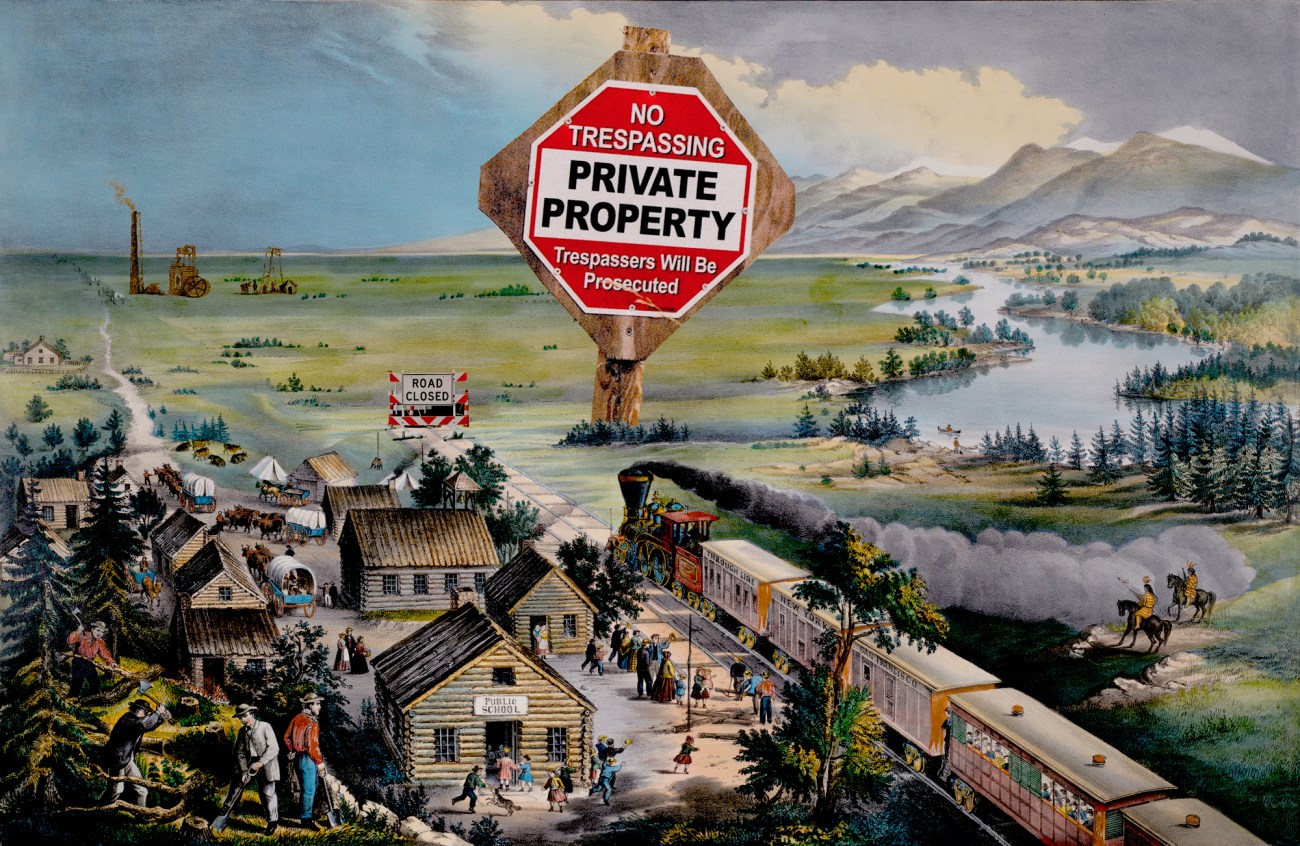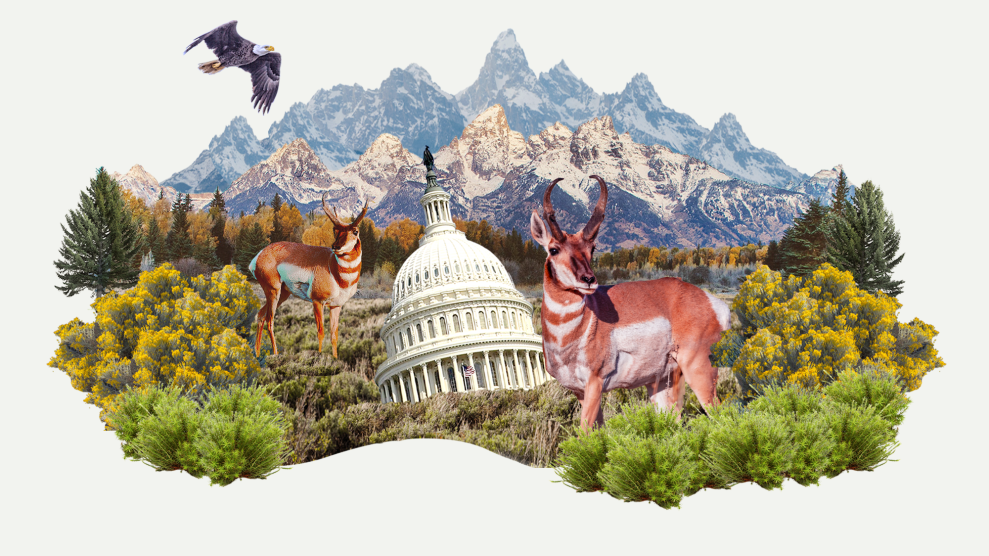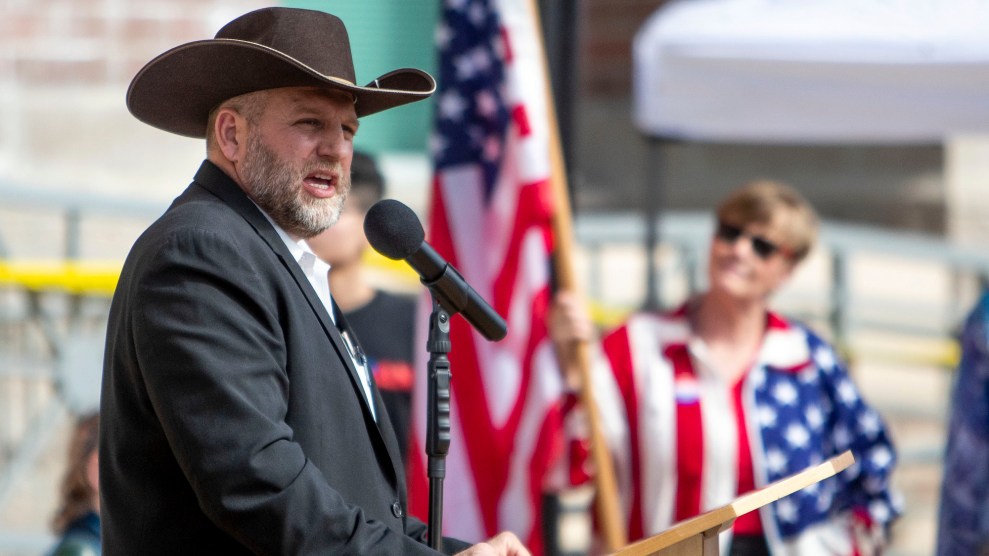Google “America’s Best Idea” and you’ll find there’s a clear frontrunner: our national parks. The United States has 63 now, including southern swamps and deep mountain canyons and forests of saguaro cacti, a collection of beloved landscapes that stretches, to quote the familiar song, “from sea to shining sea.”
But America’s preeminent property rights activist, Margaret Byfield, sees these parks differently. They were created at the behest of 19th-century robber barons, she says, who wanted to ensure that no one else could match their wealth or power. And that was just the beginning. Now a new generation of robber barons is “coming for the rest of the land,” she warns a collection of ranchers, lobbyists, and politicos gathered in Dallas last September.
I am one of several hundred attendees at the second “Stop 30×30” summit, a conference sponsored by Byfield’s nonprofit, American Stewards of Liberty. Upon checking into a towering Marriott hotel the night prior, I’d received a keepsake tote bag that featured a silhouette of a hard-riding cowboy atop the words “Land & Liberty.” The phrase offers a succinct summary of ASL’s gospel: Liberty is paramount, and can only be achieved through ownership of land. “Either you own property or you are property,” Byfield likes to say.
To help ward off what they perceive to be such threats to American independence, ASL has spent decades building a grassroots coalition. They’ve counseled local officials on how to slow the implementation of federal projects, whether the designation of a new wilderness area or the imposition of a highway. And they’ve waged aggressive campaigns to delist endangered species, whose presence can limit owners’ use of their land.
But this summit represents a new—and potentially more lucrative—turn for the group. Byfield and her husband, Dan, have capitalized on a growing MAGA-inflected backlash to Biden’s effort to conserve wild lands through their creation of a sideshow to the Trumpian political circus. My ticket to the show cost $225.
Behind the podium, Byfield favored pantsuits and dark dresses, the cool attire of a corporate executive. She spoke in calm and measured tones, but her urgency was palpable. “What do we want our country to look like?” she asks the crowd, her head flanked by no fewer than six American flags. “Do we want it to be owned and run by the environmental community? And the wealthy elite? Or do we want it to be owned and run by the people, which is how it was meant to be?”

I consider myself a nature critic, which is to say I write about the human relationship with the environment. So for several years, I have been tracking the Biden administration’s campaign to conserve 30 percent of US land and water by 2030—“30×30,” as the goal is typically known. Gradually, I came to realize that more interesting than the campaign itself (which has felt, at times, halting and disorganized) was the opposition to it. The tale spun by American Stewards of Liberty can feel like a James Bond movie without the glamour, with Biden and his wealthiest supporters cast as villains who aim to conquer and shackle the natural world. But it’s also got the appeal of an episode of Yellowstone, invoking the halcyon days of the rugged American frontier.
That frontier rhetoric is why I’m not surprised when, after an obligatory pledge of allegiance, Dan Byfield—a professorial, white-haired Texan who serves as ASL’s CEO—opens the conference with a brief history lesson. The Texas Revolution, the war that helped Texas split from Mexico, he says, was an example of “true bravery.” (He fails to note that those brave Texas soldiers helped protect and expand the institution of slavery.)
He could have hearkened back even further since the feud over public acreage goes back to the birth of the nation itself. After the Revolutionary War, states begrudgingly gave up territorial claims west of the Appalachian Mountains. The new federal government needed this land for military bounties and to sell to farmer settlers. In her opening remarks, “Assault on America,” Margaret fast-forwards the narrative to the moment a century later when new laws set aside some landscapes as symbols of the nation’s beauty. That’s how we got Yellowstone National Park, established in 1872, and, soon afterward, other parcels that were designated “forest reserves” and carefully managed to ensure an endless supply of timber. But it wasn’t until 1976 when Congress passed the Federal Land Policy and Management Act that Washington moved to fully end the land sales. Congress charged several agencies with managing the more than 650 million acres that remained for, among other uses, science, archeology, wildlife, water, and recreation.
This turned out to be an astoundingly popular decision. Polls consistently show that the majority of Americans support the country’s public lands and parks, and favor safeguarding even more ground. But in some rural counties—where large portions of land remained federal property, thereby putting a damper on development and the local tax base—the end of land sales sparked what became known as the Sagebrush Rebellion.
The movement, which had coalesced before the Federal Land Policy and Management Act even passed, aimed to have federal land transferred to the states. This was in part an expression of earnest populist fury. But according to Yale historian Greg Grandin, it also doubled as a lobbying front for extractive industries, including “big ranchers, land developers, miners, lumber companies, and independent oil ranchers.” The rebellion’s spirit lives on most prominently in the cowboy antics of the Bundy family, who have repeatedly spearheaded armed standoffs against federal authorities—actions that many see as precursors to the January 6 attack on the US Capitol.
Margaret Byfield’s passion for property rights almost seems predetermined. Her father Wayne Hage’s family had been ranching out West since before the Civil War. According to an obituary, Hage himself dropped out of high school in 1952 to help his neighbors weather a bad winter. Nonetheless, he was erudite and ambitious, eventually passing a high school equivalency exam and earning a master’s degree in animal husbandry from the University of Nevada. Hage dismissed the Sagebrush Rebels as lacking a “real philosophy.” They were too motivated by antagonism toward the federal government, he believed, and naive in imagining that state ownership of federal lands would be preferable. At the behest of a friend, he wrote a 1989 book titled Storm Over Rangelands, an extended argument as to why ranchers like him ought to be granted ownership of the public rangelands. He had a stake in the fight: In 1978, Hage had spent $2 million on a ranch that sprawled over 7,000 acres in Nevada and included rights to grazing another 750,000 acres of federal lands.
ASL is selling copies of Hage’s book at the summit, so I spend a few spare hours in Dallas skimming it. Some of his arguments had merit: For all the democratic appeal of national parks, it seems likely that wealthy capitalists and industrialists supported the creation of Yellowstone mostly out of self-interest. By locking up land sales, they’d ensure no one out West could accumulate enough capital to compete; by controlling the one railroad to the park, they’d profit from the new tourism business.
But Hage’s legal theorizing was less convincing. He argued, based on little more than wishful thinking, that ranchers who grazed cattle on public land and had earned water rights had thereby developed a legal claim to own the full estate. Hage was confident enough in his theory that, in 1991, after federal agents seized 100 of his cattle grazing in the Humboldt-Toiyabe National Forest, he took the government to court. The ensuing lawsuits would not end until 2017, after the 9th Circuit Court emphatically rejected the heirs pressing his argument. The case was sent back to district court, where a judge ruled that the family owed the government more than half a million dollars. By then Hage had been dead for more than a decade. The ranch went into foreclosure; Hage’s son, Wayne Jr., who’d taken over the operation, packed up and moved out.
Hage had five children, including several daughters who launched political careers advocating for property rights. Margaret (then Gabbard) had graduated from the College of Idaho a few years before her father’s lawsuit dropped—she’d earned a degree in music and English—and quickly organized a raffle fundraiser to help him pay his legal fees. The prize was a cowboy painting by a friend of the family titled Stewards of the Range. By 1994, that early effort had grown into a formal nonprofit, also called Stewards of the Range, which aimed to “promote and defend” property rights.
By the late ’90s, Margaret was looking beyond the West, fighting a Clinton administration plan to designate the Upper Mississippi as an “American Heritage” river. “The power it would give the president is almost untouchable,” she told reporters at the time. Her key tactic was what she called the “Liberty Matters News Service.” By fax machine, she disseminated inflammatory disinformation, including a claim that the federal government planned to use satellites to spy on nearby property owners.
In 2002, Margaret married one of her allies, a Texas lobbyist named Dan Byfield. He also led a property rights group, the American Land Foundation, and the couple eventually merged the nonprofits, retaining elements of both their names. Thus, American Stewards of Liberty was born.
The Byfields, who did not respond to my requests for comment after the summit, soon began to market seminars and conferences where they promulgated the disputed idea that federal officials must always defer to county-level policies. That the theory has rarely been tested in courts hardly matters; the real point seems to be stoking NIMBY reprisal, creating a wave of controversy that can slow down proposed projects. Kane County, in Utah, has paid ASL nearly $1 million for such trainings. Still, compared to Margaret’s earlier antics, ASL was a quiet operation—one that, as Dan said in a 2015 newspaper profile, sought to avoid publicity. That way, he put it, they could avoid “political backlash of any kind.”

But by the first day of the Biden presidency, two weeks after the January 6 uprising, Margaret Byfield seemed ready to step back into the spotlight. She dusted off her “Liberty Matters” brand and inaugurated a biweekly email newsletter. “Liberals have been eroding our property rights for environmental causes…and inoculating Americans against truth and freedom for decades,” the first edition declared. To fight back, the newsletter suggested, conservatives had to build their own information ecosystem. And the information that she found most pressing to share was a warning: Now that Biden was in charge, a “massive land grab” was imminent.
Six days later, in an executive order, the president instructed the Secretary of the Interior to begin consulting with tribes, agencies, and private landowners to identify strategies that would allow the United States to conserve 30 percent of its lands and waters by 2030. Officially known as the “America the Beautiful” Initiative, the 30×30 initiative is in line with a global diplomatic and conservation project that envisions all nations making the same commitment. Before the initiative was launched, Byfield had already queued up the language she’d use to try to stop it—and positioned herself as a leader of the far right in the West.
Within weeks, the Byfields had produced a “Guide to Fight 30×30.” Our welcome packet at the summit included the latest edition, which claims that the Biden administration was using “the politically motivated climate crisis agenda to gain control of American’s [sic] land.” On stage, Byfield explains how the land grab supposedly will work: The government will foist restrictive easements onto those unaware of the rights they’re giving up. Then, “when they finally get enough of the landowners enrolled in these programs, they’ll start pulling the string on the net,” she says. The implication, as I understand it, is that the government will seize the territory from those who refuse to comply.

The guide also points readers toward the model resolution that the Byfields have drafted, which allows counties to express token opposition to 30×30. ASL boasts that over the past three years, 70 Western counties have passed versions of it. Biden’s program would, according to the language in the resolution, “replace the decision-making of independent Landowners who have been caring for these lands for generations” and “cause dramatic and irreversible harm” to local economies. This even though in a May 2021 report that outlined the guiding principles of the initiative, the Biden administration has promised to honor property rights and maintain ranching on public lands in the West.
Byfield reportedly advised former Nebraska Gov. Pete Ricketts on an executive order he signed opposing 30×30. ASL’s talking points were also cited in the 30×30 Termination Act, which was introduced in May 2021 by far-right Colorado Rep. Lauren Boebert. In the accompanying press release, Boebert suggested that 30×30 was meant to pander to “extremist enviros funded by George Soros that believe the federal government should control every aspect of our daily lives.” The measure, which never made it out of committee, would have nullified the original 30×30 executive order and forbid any expansion of federal holdings in states where the government already holds more than 15 percent of the land.
At the summit in Dallas, Byfield contrasts the bill with federal environmental policies: The federal government works to ensure no net loss of wetlands; under Boebert’s law, they’d have to ensure no net loss of private property. But, Byfield notes, the fight in Congress is “a long-term plan.” The real war is at the local level. And for the rest of the morning, she turns the stage over to her local warriors.
Byfield introduces speaker Vicki Marquardt and describes her as “a pistol.” A district commissioner in Otero County, in New Mexico, Marquardt holds the audience rapt with a quiet, biting sarcasm. She notes that a recent wildfire, the biggest in her state’s history, was made possible thanks to the US Forest Service, which allowed a controlled burn to blow out of control. “Who knew that would ever happen?” she asks, after noting the hot, dry, windy conditions of those days. A ranger from the Forest Service later acknowledged the agency’s culpability and apologized. But that was hardly enough for Marquardt, who found it appalling that the federal government still wants more land “when they can’t even control and take care of what they have.”
Over lunch, the day’s keynote speaker—Richard Thompson, the executive vice president of United Country Real Estate, which specializes in rural land sales—laments that too many Americans have become disconnected from nature. It’s a sentiment I agree with, which is why I think it is good to protect some land by keeping it public. But Thompson has drawn a different conclusion: This separation explains why federal bureaucrats are so bad at managing land. The bureaucrats can’t understand what landowners do; they have no feeling for the land, he says at one point: “They’re trying to dictate based on theory. They’re trying to dictate to us what we do for land use.”
That us, and its implicit them, captures the tone of the day. At one point, some errant sound—microphone feedback, by my guess—prompts Dan Byfield to speculate that leftist protesters might be encircling the building. I suffer a flash of nerves; so far as I can tell, I am the closest thing to an enemy in the midst. (I registered for the conference under my own name, and, per journalistic ethics, divulged my identity and purpose to anyone who asked.) But later, during that night’s dinner, my anxiety peaks.
The Byfields have advertised the dinner as the red-carpet premiere of No Farmers No Food: Will You Eat the Bugs?, a documentary produced by the Epoch Times, a right-wing newspaper affiliated with Falun Gong, a religious organization that strongly opposes the Chinese Communist Party. The film offers a whirlwind investigation into a global conspiracy, carrying viewers from New York City to Sri Lanka to the Hague. According to its narrative, the UN is trying to shut down family farms so they can better control the world’s population, a program ultimately ending with everyone eating crickets and mealworms. Whenever I stifle a chuckle at what sounds like satire, I notice most of the other diners nodding earnestly. During the Q&A that follows, it becomes clear that most of the several hundred viewers in this packed ballroom are not only convinced but enraged: One attendee asks the director how we might go about prosecuting the people behind this conspiracy for war crimes. When someone asks a slightly critical question—noting that many cultures have long traditions of eating insects—there is angry muttering from the crowd. I am glad I have decided to wait until the next day to ask any of my questions.
Byfield is featured prominently in the documentary, where she drops that favored line: “We either own property, or we are property.” She will repeat the charge, to applause, when she speaks on a panel at the Conservative Political Action Conference in February 2024. There, she will celebrate her latest victory: The New York Stock Exchange had recently given up on a proposed plan to create a new kind of company that could hold the rights to ecosystem services. It’s a riff on carbon credits, and an idea that raised ire on the left, from activists who also detest corporations and prefer public, communal control of natural resources. Byfield, though, does not miss a chance to stoke the culture war and keep her brand in the headlines. The concept for these companies, she said, proves that environmentalists are only after “power and money.”

The next morning, for a bit of relief from this hotheaded rhetoric, I head out for a jog at dawn—or try to. The conference venue, an airport hotel, is so ensnared in highways that I’ve got nowhere to range. Yesterday, everyone was talking about landowners as stewards, but this landscape feels like an indictment, the too-common outcome of private ownership. They’ve paved the Texas cowboy paradise and put up a parking lot.
Later, over lunch, when I reveal my journalistic identity to my tablemates, everyone is willing to chat, haltingly. One man tells me that he lives off the grid in Texas and that he and his wife bought tickets for the summit at the last minute, after hearing Byfield on Glenn Beck’s radio show. He is a self-described conspiracy theorist—but “most of mine have come true,” he says—and turns prickly when I ask for his name.
Alfredo Herrera is kinder, and softer-spoken, a young rancher whose ancestors first homesteaded their family plot in northern New Mexico 100 years ago. Now he has to be cautious not to disturb an endangered species, the Jemez Mountain salamander, that he and his family have never managed to see.
Their land is near Valles Caldera, which I later look up. It was once a privately owned ranch; the government bought the land in 2000 and turned it into a national preserve. The commissioners of the surrounding county have passed ASL’s anti–30×30 resolution, though they’re not the only ones dissatisfied with the federal government’s actions. Environmentalists contend the National Park Service has failed to keep out roving cattle. Then there’s a lawsuit that was decided a few months before this summit, awarding title to a portion of the preserve to a local Indigenous tribe, who asserted that they’d never given up the land in the first place. Valles Caldera is a reminder that most of the nation’s small-time farmers and ranchers benefited from an actual land grab.
Still, Herrera’s struggles sound real to me. Ranchers offer a powerful symbol of that cherished American ideal: rugged individualism. In 2018, the Wall Street Journal produced a romantic video about Wayne Hage’s struggles; another daughter noted that Hage allowed his cattle to range freely across rangeland, “very similar in many ways to the way cattle were run 150 years ago.” Even more liberal voices have acknowledged that if beef is to be raised sustainably in the West, by “mom-and-pop operations,” access to public land is necessary. Otherwise, the scale of rangelands required will price out anyone but the uber-wealthy.
I can’t help but wonder how much Herrera will be served by ASL’s anti-federalist agenda. I think of how cattle ranchers in southern Florida have embraced a very different approach: They’ve partnered with the federal government to keep out the concrete, selling conservation easements that entail giving up some of their land rights. They figure that if the land is kept intact to save the endangered panther, the encroachment of condos and residential neighborhoods will be blocked.
When I ask what he’s gotten out of the ASL summit, Herrera tells me, “It’s comforting to know you’re not alone.” All weekend long, there has been talk of “grassroots.” At the time, ASL’s website declares that 54 percent of its hundreds of thousands of dollars in annual revenue comes from small donors. (The vast majority of that money is spent on the couple’s salaries.) But that note will disappear at some point in the months after the conference. The group’s 990s tell a different story: “Service fees”—money that comes presumably from their county-level consulting and, lately, their summits—make up more than two-thirds of ASL’s revenue. The most prominent sponsor of both of the group’s summits has been the Committee for a Constructive Tomorrow (CFACT), a think tank funded by, among other donors, ExxonMobil and the Koch brothers. And what is their opposition to the federal government? It strikes me as more likely about keeping the oil flowing than keeping cowboys on the land.
Over our final lunch, a CFACT employee, Marc Morano, shouts his way through a rapid-fire PowerPoint detailing his Tucker Carlson–approved theory. It’s a riff on the same ideas we heard in the documentary the night before: Globalist elites. Climate hoaxes. Suppers of mealworms. Herrera and our tablemates listen attentively, but I keep returning to Margaret Byfield’s opening talk: “When you’re not fighting from the premise of truth, you are vulnerable.”
Do operators as savvy as the Byfields really believe Morano’s outlandish claims? Who do they want to own this country? If I squint a bit, this conference starts to look like a front on behalf of the oligarchs who pay the bills—the people who, if our public lands are ever privatized, will wind up the new owners. But maybe I’m just prone to conspiratorial thinking.
















